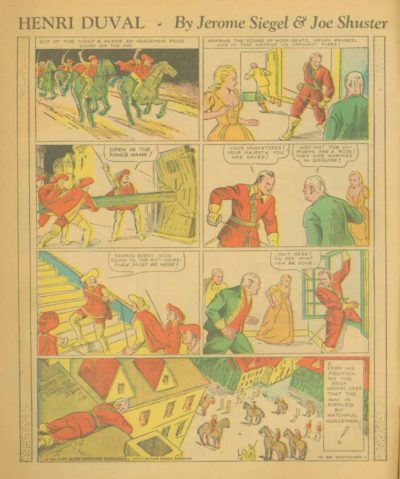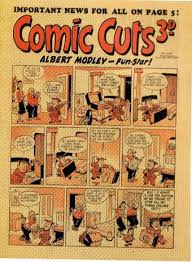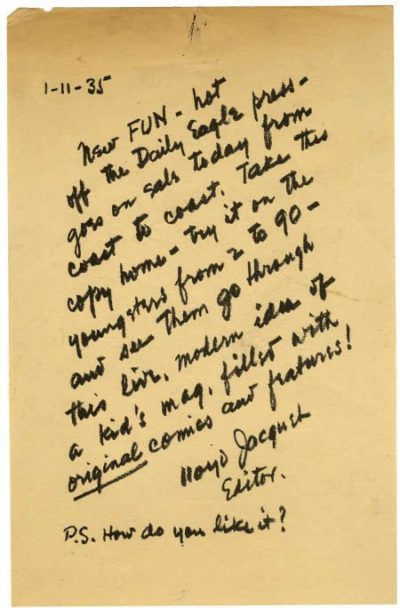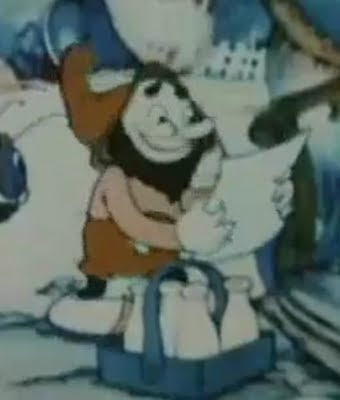For Super Sleuth DC Fans: An ongoing look at 86 years of DC Comics, beginning with New Fun #1, January 11, 1935 through March 1938.
Contributor mini bios: Lloyd Jacquet, Rexford L. May, D. Henry Cushing, Richard Loederer, Sheldon Stark
New Fun #1 published by Major Malcolm Wheeler-Nicholson marks the beginning of DC Comics 85 years ago. It appeared on newsstands January 11, 1935 with a February date. The comic Jack Woods was in color on the cover. It was drawn by Lyman Anderson with a script most likely by the Major. The 32 interior pages were black and white. The back cover was also in color and featured a Tom Mix comic as an ad for Ralston Purina. The tabloid sized comic was printed by the Brooklyn Daily Eagle.

That same month the Major’s pulp adventure story “The Secret Empire” written for the Street and Smith pulp Bill Barnes Air Adventurer appeared on newsstands. According to Will Murray MWN co-created the character with Street and Smith’s editor Henry Ralston. It would be the last story MWN would write for the Bill Barnes run under the pseudonym George L. Eaton. It is one of the few pulp stories published during the Major’s comics publishing endeavor.

When I initially began researching 23 years ago I understood the Major’s comics from January 1935 through April 1938 to be part of the Golden Age of comics. I don’t think I’m alone in that view. Recently I’ve seen some comics scholars and historians relegate the Major to the Platinum Age, in some antediluvian past. The end result is that often the Major and his era are ignored in discussions of the continuum of comics going from “the first” comic book to Action #1. This is unfortunate as not only were there innovations in the Major’s era that became the norm for modern comics but many of the artists and writers like Siegel and Shuster began their careers in the Major’s comics. I believe the Major deserves his own category—the Major’s Modern Era.

Henri Duval, More Fun #8
The best innovations begin on a foundation of that which has been proven to be successful. New creations are formed from the old. According to Lloyd Jacquet, the editor for New Fun #1-4 during 1934, when they were putting the first magazine together, the Major was aware of “a British paper called “Comic Cuts…” However, Jacquet stated in an article written in 1957 that “…Major Nicholson was more aware than ever that this was not the answer to a possible wide sale for a series of juvenile publications of particular design and appeal.” From the beginning MWN saw the magazines as having a broader appeal than simply funny comics for children.

One of the innovations of the Major’s new comics featuring all original material is that many of the scripts were based on MWN’s experience as a writer for adventure pulp magazines. Jacquet pointed out in the same article, “Major Nicholson’s pulp magazine background helped here, for it was a natural step from the “general” title of comics (of the funny type, incidentally), to the western, and the detective, aviation, and so forth, that were even then the backbone of the pulp mag sales on the newsstands all over.” The comic “Barry O’Neill and Fang Gow” initially illustrated by Lawrence Lariar in New Fun #1 was from a pulp story by the Major. Many of the writers and artists began and continued their careers working in the pulps. These stories laid the groundwork for the kinds of stories continuing to be told in today’s comics. One cannot fully understand the Major’s era without some knowledge of his writing for the pulps.

New Fun #1 got off to a good start with several established professionals on the editorial and management staff. Lloyd Jacquet (1899-1970) was one of several people associated with the Brooklyn Daily Eagle involved in New Fun #1. The Eagle had been publishing for almost 100 years at that point and the 19th century poet Walt Whitman had been one of the illustrious editors. Jacquet began contributing to the Brooklyn Daily Eagle as a teenager writing letters about his avid interest in amateur radio. After serving in the Navy during WWI, he continued to write about amateur radio with a column syndicated by McClure and began a career as a contributing writer and editor for a number of newspapers. His foray into comics is intriguing since his main background was as an editor. Although he was connected to some of pulps’ shadier publishers he seems to have maintained a good reputation throughout his life. Jacquet is noted for founding Funnies, Inc. in 1938, which would connect him to the pulp publisher Martin Goodman, the founder of Marvel Comics. For New Fun #1 he most likely contributed the prose articles “On the Radio,” and “In the Movies.”

Unlike later unfavorable depictions of the Major, Lloyd Jacquet spoke highly of him in the 1957 article. “These events occurred during 1934, 1935, and 1936 – and truly are the ‘beginnings’ of the comic book business. Nobody knew then where it was going, nor would any one hazard a guess. But Major Nicholson’s quiet determination, resourcefulness in the face of many odds and situations pushed the whole thing alone until his progress started to be noticed by others.”

The masthead listed Rexford L. (Linneaus) May (1883-1948) as the Circulation Manager. He was also connected to The Brooklyn Daily Eagle in newspaper promotion. May came from a fairly well to do family, and after graduating from the Lewis Institute in Chicago moved to Brooklyn and worked on Wall Street. After the 1929 crash he began working in newspaper promotion and in 1940 was promoting the World’s Fair. Other than newspaper promotion and whatever those connections were, he doesn’t appear again in the larger story of pulps to comics and his involvement with the Major’s publishing era appears to have ended with New Fun #6.

D. (Henry Dwight) Cushing, (1882-1954) was listed as the advertising manager. His life followed a similar path to the Major’s. After graduating from Dartmouth he became a captain in the Massachusetts National Guard and in 1915 served on the Mexican Border chasing Pancho Villa. By 1915 the Major was in the Philippines so it’s not clear if their paths intersected however they had a lot in common. Cushing commanded a machine gun battalion during WWI and his wife, who was Spanish drove ambulances during the war. After the war Cushing worked for Eastern Distributing Corporation as a salesman and undoubtedly knew Harry Donenfeld. He handled advertising for Harold Hersey’s pulp magazine publishing company as well as a number of pulps published by Donenfeld. He and Lloyd Jacquet with Harold Hersey formed CJH publishing in 1936. I mention these connections among this group of publishers to reveal the larger picture of the various characters and entities that knew one another and did business with one another. Cushing also ended his connection to the Major after New Fun #6. With the formation of a new company More Fun Inc. to publish More Fun #7, my guess is that this was a financial decision.

The Art Director for New Fun #1-6 was Dick (Richard) Loederer (1984-1981) and what a great choice to establish the style of the new magazines. Loederer, an Austrian, studied at the Reinmann Schule in Berlin and the Vienna Academy of Fine Arts. He worked in advertising in New York in the 1920’s and for RKO studios in 1928. The Fun Gnomes on the opening page of New Fun #1 have been compared to The Sunshine Makers, an animated film with similar characters. Loederer lent his distinctive style to New Fun and most likely created the logo. He created the headings and contributed “Caveman Capers” and “Bubby Beezil” for New Fun #1.

Sheldon H. (Hubert) Stark (1909-1997) was listed as the Cartoon Editor for New Fun #1 and 2. Stark was a writer of some note in later years. He has been credited with the scripts for Oswald the Rabbit along with several others and may have contributed to some of the uncredited scripts and possibly some of the editorial content.

Upon opening the magazine, the first comic was Sandra of the Secret Service beautifully illustrated by Charles Flanders. It’s an interesting choice to give this comic such prime real estate and for this and other clues I’m pretty sure Sandra was created by the Major. Flanders was not known for creating characters and certainly not one like Sandra. She was the first female heroine for DC pre-Wonder Woman and we’ll learn more about her in New Fun #2.

The following pages of the magazine contained 17 original comics, a comic of the classic Ivanhoe, several prose pieces and activities for children. The artwork and scripts were as varied as their authors unlike today’s corporate look in comics. It was a good beginning for the Major’s vision for the modern American comic book. There’s lots more to come. Stay tuned.
